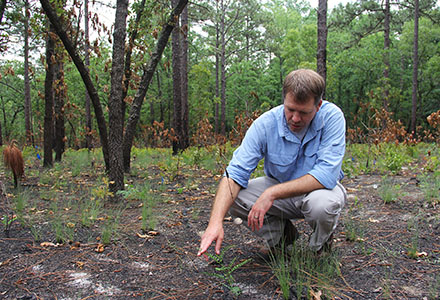It may come as a surprise to many, but the military is one of the country’s strongest advocates for wildlife and plant conservation. In the case of Fort Bragg, two-thirds of this 500-square-mile installation act as training grounds that sit on a rich bed of rare and endangered plant species which is why it is known as one of the country’s largest reservoirs of biodiversity. Some plant species on the base are almost exclusively limited in location to Fort Bragg, such as the Georgia indigo bush. This essentially means that the loss of one plant species on this base could mean the loss of the majority of that plant species’s population in the world .
.
For that reason, ENEC PhD candidate Mike Kunz and ENEC Adjunct Professor Johnny Randall have been working with the North Carolina Botanical Garden (NCBG), a leader in native plant conservation and education in the Southeastern United States, and the Endangered Species Branch at Fort Bragg with the mutual goal of being committed to conserving biological diversity on the military base. They plan on doing so by reintroducing several plant species at risk of extinction into different areas throughout the base. Specifically, the conservationists have been utilizing blue and red flags across Fort Bragg’s forest in order to mark rare and endangered plants for further study. Kunz utilizes these markers to take demographic measurements like height , width, stem diameter and the number of flowers and seeds produced on each individual plant.
The result of these conservation efforts have gone beyond the scope of just the rare and endangered plants that reside on the base. Janet Gray, Fort Bragg’s endangered species botanist, says the research methods being done on these rare and endangered plants is helping them make large steps towards knowing how to perpetuate and maintain the population of other rare and endangered plant species throughout the world. One of these methods involves burning the land the plants are on to stimulate germination and prevent more serious fires. Luckily, the regular training and routine live ammunition work conducted at Fort Bragg throughout the year helps spark these much needed wildfires. Without those wildfires, Mike Kunz believes a large amount of the rare plant species would have gone extinct a long time ago.
Overall, a part of Fort Bragg maintaining its finite training land revolves around protecting the rare plant population on the base which requires consistent collaboration with environmental agencies such as the Nature Conservancy and the North Carolina Botanical Garden. To this day, Fort Bragg’s conservation efforts serve as a national model for other military installations and help to inspire others through their unyielding dedication towards protecting the environment around them.
